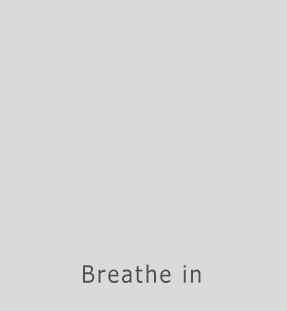Breathing exercises are well known to reduce feelings of stress, anxiety and panic.
When we’re stressed, heart rate, breathing rate, and blood pressure all increase. And when we breathe deeply, we’re mimicking the way we feel just before we fall asleep or when we first wake up - two of the moments when our bodies are most relaxed. Our brains respond to these physical signals and our heart rate and blood pressure begins to fall, which in turn makes us feel less stressed.
The link between heart rate and breathing rate is well known. In fact, we've already blogged about how choir singers (who breathe at the same rate because they are singing the same song) can synchronize their heart rate.

Whilst you’ll get the most benefit if you do it regularly, deep breathing can also help you feel more calm on demand.
Here are three techniques you can try almost anywhere. Unless specified, all exercises can be done standing up, sitting in a chair that supports your back, or lying on a bed or yoga mat on the floor.
4-7-8 breathing
- To start, put one hand on your belly and the other on your chest
- Take a deep, slow breath from your belly, and silently count to 4 as you breathe in.
- Hold your breath, and silently count from 1 to 7. You may not be able to reach 7 at first.
- Breathe out completely as you silently count from 1 to 8. Try to get all the air out of your lungs by the time you count to 8.
- Repeat 3 to 7 times, or until you feel calm.
Roll breathing
Roll breathing helps you to develop full use of your lungs and to focus on the rhythm of your breathing. You can do it in any position. But while you are learning, it is best to lie on your back with your knees bent.
- Put your left hand on your belly and your right hand on your chest. Notice how your hands move as you breathe in and out.
- Practice filling your lower lungs by breathing so that your "belly" hand goes up when you inhale and your "chest" hand remains still. Always breathe in through your nose and breathe out through your mouth. Do this 8 to 10 times.
- When you have filled and emptied your lower lungs 8 to 10 times, add the second step to your breathing: inhale first into your lower lungs as before, and then continue inhaling into your upper chest. Breathe slowly and regularly. As you do so, your right hand will rise and your left hand will fall a little as your belly falls.
- As you exhale slowly through your mouth, make a quiet, whooshing sound as first your left hand and then your right hand fall. As you exhale, feel the tension leaving your body as you become more and more relaxed.
- Practice breathing in and out in this way for 3 to 5 minutes. Notice that the movement of your belly and chest rises and falls like the motion of rolling waves.
Practice roll breathing daily for several weeks until you can do it almost anywhere. You can use it as an instant relaxation tool anytime you need one.
Some people get dizzy the first few times they try roll breathing. If you begin to breathe too fast or feel lightheaded, slow your breathing. Get up slowly.
Morning breathing
Try this exercise when you first get up in the morning to relieve muscle stiffness and clear clogged breathing passages. Then use it throughout the day to relieve back tension.
- From a standing position, bend forward from the waist with your knees slightly bent, letting your arms dangle close to the floor.
- As you inhale slowly and deeply, return to a standing position by rolling up slowing, lifting your head last.
- Hold your breath for just a few seconds in this standing position.
- Exhale slowly as you return to the original position, bending forward from the waist.
Sources: WebMD and NHS
doppel for Stress
Many of our customers have to deal with stress on a daily basis, either as part of an ongoing condition, or simply through parts of their lives like their career or parenting. Some of our customers have shared their experiences using doppel and how it them deal with stress.
Oliver - COO at a Non-Profit Institute
“I became interested in doppel while working in a very stressful leadership position. I had a fidget spinner, but you can’t really take those out in meetings - that’s a little hard in my world. Now, I use doppel throughout the day to keep me grounded. In those stressful instances, it slows me down and keeps me more focused on the moment.”
You can read more about what people have said about how doppel helps them at our Testimonial page, and more information about doppel can be found here and at our Science page.
Related Posts:
3 Breathing Techniques to Beat Stress
Back to School - Our Top Focus and Concentration Tips
